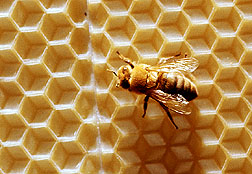Allergies: From bee stings to peanuts
As more and more people develop allergies, researchers are looking for ways to treat and prevent severe allergic reactions.
By Emily Sohn
The bee sting hurt so much that I stopped my bike just to yelp. I checked the swelling on my thigh to make sure the stinger was gone. Then I kept on biking.
About 15 minutes later, my ears and armpits started to itch like crazy. A rash appeared on my arms. My lips and eyelids began to puff up. Pretty soon, I had to get off my bike because I was having trouble breathing. My chest felt constricted. My heart was racing. Itchy welts were popping up all over my body and inside my throat. My eyes were starting to swell shut.
 |
|
A bee sting can cause a severe allergic reaction in some people.
|
| Jack Dykinga/U.S. Department of Agriculture |
In a panic, I grabbed my cell phone and called 911. I was having a severe allergic reaction to the bee sting. Without help, I knew there was a chance I could die.
“More people die from bee stings than from dog bites every year,” a doctor told me when I finally arrived in the emergency room after a nerve-wracking ambulance ride.
“Allergies in general are increasing in the population,” says Marc McMorris. He’s a pediatric allergist at the University of Michigan Health System in Ann Arbor.
More than 50 million people in the United States have serious allergies. And not just to bees. Food allergies cause even more deaths than bee stings, McMorris says.
Allergies to peanuts, in particular, are on the rise, along with reactions to ragweed, mosses, molds, cats, dogs, and shellfish. Name just about anything, and you’ll probably find someone allergic to it.
Puzzling details
As more and more people develop allergies, researchers are trying to understand what causes allergic reactions. Their hope is to find better ways of treating and preventing such reactions, which can sometimes be life threatening.
Many details remain mysterious, however. It’s not clear, for example, why different people react to different things, even within the same family.
“I treat a family with eight children, and they’re all allergic to some degree,” McMorris says. “Some have asthma, some have eczema, some have bee allergies. They’re all different. It’s just by chance that one person is allergic to one thing, while another person is allergic to something else.”
An allergy begins when the body encounters a foreign object, such as pollen, nut proteins, or bee venom. At first exposure, the body’s immune system reacts as if the object were a germ or parasite. It produces proteins called antibodies, which fight the intruder, or allergen.
 |
|
Nearly 600,000 children in the United States suffer from an allergy to peanuts.
|
| Jack Dykinga/U.S. Department of Agriculture |
After your body makes the type of antibodies that trigger allergies, these antibodies stick around in your bloodstream as a sort of memory of the incident. After that, if you’re prone to allergies, repeated exposure to the same allergen can cause your immune system to freak out.
That’s exactly what happened to me. I had been stung by plenty of bees in the past. On those occasions, the area around the attack swelled up like a marshmallow in a microwave. This time, though, as soon as the bee venom entered my bloodstream, antibodies latched onto cells in my blood. These cells then released chemicals called histamines, which caused the swelling, itching, wheezing, and other symptoms. Severe reactions like mine are called anaphylaxis.
Now that the antibodies in my blood are primed to react to bee venom, every sting I get in the future will probably cause an even worse reaction.
In some ways, though, I feel lucky. At least, I’m not allergic to peanuts.
Troubling peanuts
People with supersensitive peanut allergies can have anaphylactic reactions just from being in the same room as peanut dust. My friend Karen, for one, can’t eat jelly if you used the peanut-butter knife to spread it.
“I’ve had kids react after being licked by someone’s dog who just ate dog food with peanut butter in it,” McMorris says.
 |
|
All sorts of products, including many candies, contain peanuts or peanut oil. Even candy that doesn’t contain peanuts can cause an allergic reaction if it is made in a factory that also processes peanuts for other products.
|
| Jack Dykinga/U.S. Department of Agriculture, Agricultural Research Service |
More than 1.5 million Americans are allergic to peanuts. This number is growing, but nobody knows why. One possible cause is that pregnant women and nursing mothers may be eating peanuts before their babies have strong enough immune systems to cope with peanut proteins.
Peanut butter might be another big problem, suggests one recent study by the U.S. Department of Agriculture. The United States lags behind China and India in peanut butter production. But people in the U.S. have more peanut allergies. That might be because U.S. producers dry roast peanuts instead of boiling them, the new study suggests. Dry roasting appears to change the peanut protein into a form that triggers a more powerful allergic reaction.
Some scientists have been working to develop new strains of peanuts that are less likely to provoke an allergic attack. Other researchers are searching for new vaccines to prevent allergies from developing in the first place. One drug that shows promise was identified last year.
Being careful
For now, awareness and preparation are the best weapons, McMorris says. Some schools are banning peanut butter and jelly sandwiches in their lunchrooms. Allergic people are encouraged to carry special shot dispensers called epipens with them at all times.
I now have two epipens that I’ll jab into my leg next time I get stung. I also carry Benadryl, which blocks the action of histamines. The paramedics that rescued me after the bee sting put in a tube that delivered Benadryl straight into my vein. The hives and itching stopped almost immediately.
Even if you’ve never had an allergic reaction, it’s worth knowing how to recognize the signs. Allergies like mine can pop up at any time. Ingredients such as peanut dust can get into foods without warning, especially if factories or restaurants reuse dishes or utensils.
You might even be able to save the life of one of your friends. In one study, McMorris found that allergic kids, teenagers, and college students rarely carry epipens or tell their roommates or friends about their allergies. If you know what to look for, you can run for help in case of emergency.
“This is very serious business,” McMorris says. “You need to respect kids with food allergies. You have to take good care of your friends.”
Going Deeper:







